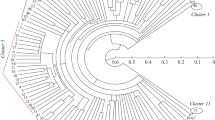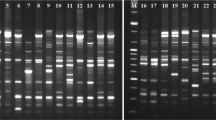Abstract.
The potential of bulk analyses of RAPD and ISSR-PCR markers for fingerprinting purposes was evaluated using ten RAPD and ten ISSR primers. The phylogenetic relationships of 16 barley cultivars from different countries, and all having a known pedigree, were analysed using 353 PCR markers (125 RAPDs and 228 ISSRs). The band profiles generated were reproducible in spite of the different DNA extractions, PCR techniques, electrophoretic methods and gel scorings used. The RAPD primer S10 and four ISSR primers (811, 820, 835 and 881) were both able to distinguish all cultivars. A strong and quite linear relationship was observed between Resolving Power (Rp) of a primer and its ability to distinguish genotypes. The dendrograms obtained using these two molecular markers are in agreement with their known origin, showing clusters that separate very well the spring/winter and six-rows/two-rows cultivars. Thus, bulk analyses of RAPD and ISSR PCR markers provides a quick, reliable and highly informative system for DNA fingerprinting and also permit to establish genetic relationships which agree with, by other means, known origin of the cultivars.
Similar content being viewed by others
Author information
Authors and Affiliations
Additional information
Electronic Publication
Rights and permissions
About this article
Cite this article
Fernández, .M., Figueiras, .A. & Benito, .C. The use of ISSR and RAPD markers for detecting DNA polymorphism, genotype identification and genetic diversity among barley cultivars with known origin. Theor Appl Genet 104, 845–851 (2002). https://doi.org/10.1007/s00122-001-0848-2
Received:
Accepted:
Issue Date:
DOI: https://doi.org/10.1007/s00122-001-0848-2




